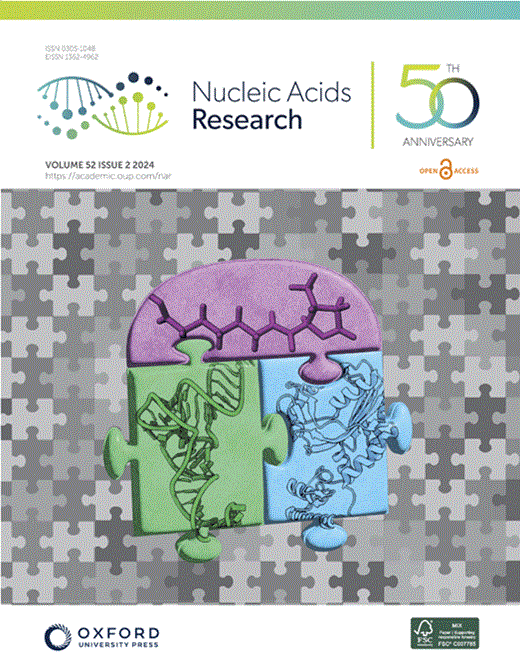利用转换器和碱基配对模式推进 microRNA 目标位点预测
IF 16.6
2区 生物学
Q1 BIOCHEMISTRY & MOLECULAR BIOLOGY
引用次数: 0
摘要
微RNA(miRNA)是参与各种细胞过程的非编码短RNA,在基因调控中发挥着至关重要的作用。鉴定 miRNA 靶标仍然是一项核心挑战,对于阐明复杂的基因调控网络至关重要。传统的计算方法主要侧重于通过种子区内完美的沃森-克里克碱基配对(称为典型位点)来鉴定 miRNA 靶点。然而,新出现的证据表明,完美的种子配对并不是 miRNA 介导调控的先决条件,这凸显了识别不完美或非规范位点的重要性。为了应对这一挑战,我们提出了一种新的计算方法--Mimosa,它采用 Transformer 框架来加强 miRNA 靶点的预测。Mimosa 通过整合上下文、位置和碱基配对信息来捕捉深度属性,从而提高其预测能力。Mimosa 独有的识别非经典碱基配对模式的能力使其成为一个杰出的模型,减少了对预选候选靶标的依赖。通过广泛的基准测试,Mimosa 在基因水平预测方面表现出色,在各种非人类物种的位点水平预测方面也表现不俗。为了促进 miRNA 靶向的研究工作,我们开发了一个易于使用的网络服务器,用于进行全面的端到端预测,该服务器可在 http://monash.bioweb.cloud.edu.au/Mimosa 上公开获取。本文章由计算机程序翻译,如有差异,请以英文原文为准。
Advancing microRNA target site prediction with transformer and base-pairing patterns
MicroRNAs (miRNAs) are short non-coding RNAs involved in various cellular processes, playing a crucial role in gene regulation. Identifying miRNA targets remains a central challenge and is pivotal for elucidating the complex gene regulatory networks. Traditional computational approaches have predominantly focused on identifying miRNA targets through perfect Watson–Crick base pairings within the seed region, referred to as canonical sites. However, emerging evidence suggests that perfect seed matches are not a prerequisite for miRNA-mediated regulation, underscoring the importance of also recognizing imperfect, or non-canonical, sites. To address this challenge, we propose Mimosa, a new computational approach that employs the Transformer framework to enhance the prediction of miRNA targets. Mimosa distinguishes itself by integrating contextual, positional and base-pairing information to capture in-depth attributes, thereby improving its predictive capabilities. Its unique ability to identify non-canonical base-pairing patterns makes Mimosa a standout model, reducing the reliance on pre-selecting candidate targets. Mimosa achieves superior performance in gene-level predictions and also shows impressive performance in site-level predictions across various non-human species through extensive benchmarking tests. To facilitate research efforts in miRNA targeting, we have developed an easy-to-use web server for comprehensive end-to-end predictions, which is publicly available at http://monash.bioweb.cloud.edu.au/Mimosa.
求助全文
通过发布文献求助,成功后即可免费获取论文全文。
去求助
来源期刊

Nucleic Acids Research
生物-生化与分子生物学
CiteScore
27.10
自引率
4.70%
发文量
1057
审稿时长
2 months
期刊介绍:
Nucleic Acids Research (NAR) is a scientific journal that publishes research on various aspects of nucleic acids and proteins involved in nucleic acid metabolism and interactions. It covers areas such as chemistry and synthetic biology, computational biology, gene regulation, chromatin and epigenetics, genome integrity, repair and replication, genomics, molecular biology, nucleic acid enzymes, RNA, and structural biology. The journal also includes a Survey and Summary section for brief reviews. Additionally, each year, the first issue is dedicated to biological databases, and an issue in July focuses on web-based software resources for the biological community. Nucleic Acids Research is indexed by several services including Abstracts on Hygiene and Communicable Diseases, Animal Breeding Abstracts, Agricultural Engineering Abstracts, Agbiotech News and Information, BIOSIS Previews, CAB Abstracts, and EMBASE.
 求助内容:
求助内容: 应助结果提醒方式:
应助结果提醒方式:


